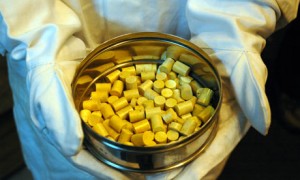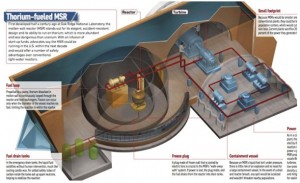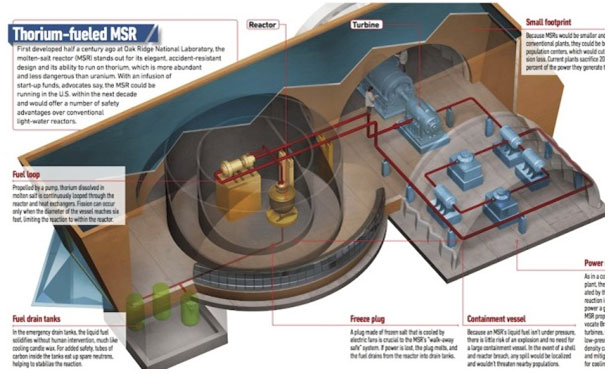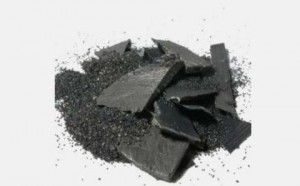China in its push to reduce its dependence on coal-fired power plants sees thorium liquid salt reactors (TMSRs) as an important step in developing clean energy technology. Not only will they provide electrical power, but also will provide hydrogen, methanol and other byproducts. China has had trouble getting its first TMSR up and running but they remain the leader at this moment, ahead of planned projects in France and India (the latter country is experimenting with solid thorium-fueled water-cooled reactors). The U.S. developed a prototype in the 1960s but shelved it. But now China is in the forefront with a target completion date of 2020. Westinghouse is advising on the project.
Thorium (seen below) is a radioactive element. It is widely abundant in the Earth’s crust. Its radioactive half-life is much shorter than uranium or plutonium. And its byproducts are of no value for making nuclear weapons.
What are the advantages of thorium reactors and particularly thorium molten salt?
- Thorium is far more abundant than uranium and plutonium.
- A TMSR can harness up to 98% of the energy from the fuel it burns. Compare that to current reactors which obtain efficiencies of between 2 and 5% in a given volume of plutonium or uranium.
- The molten salt is liquid which expands when heated. This slows the nuclear reaction and creates a much safer technology than traditional fuel rod reactors.
- The reactor is self-governing with a drain with plug at the bottom of each molten salt container. Should something go wrong the plug melts and the molten salt drains into a shielded underground container.
- Molten salt reactors are not limited to burning thorium. They can consumer different nuclear fuels including nuclear fuel waste and use it as an energy source. That makes them highly attractive as a means of consuming spent uranium and plutonium from existing reactors. And the small part of the fuel residue from TMSRs is Plutonium 238, used by NASA for Deep Space Missions as a heat and energy source for missions like Cassini or the Mars rover, Curiosity.
- Another byproduct is Molybdenum 99 used in medical diagnostics. Currently the source of such radioactive diagnostic imaging materials has been compromised by a worldwide shortage when Canada’s Chalk River nuclear reactor sprung a leak and subsequently, the country decided to phase it out of operation.
Thorium has been called a super fuel by writers such as Richard Martin who recently published a book by that same name. In it Martin argues that using thorium fuel in existing reactor technology would be far safer than the fuels we use today. He states that the only reason most of the world uses uranium and plutonium dates back to the beginning of atomic weapons programs in the 1940s. He blames the military for the aborted thorium prototype shelved by the U.S. in the 1960s.

The fact that China has taken the lead in building the first TMSR speaks to the reality that country faces as it deals with its growing energy demand. The Chinese have shut down conventional nuclear power plant projects and scaled back their plans because of obvious concerns with safety issues brought to light by the disaster at Fukushima, Japan, following the 2011 earthquake and tsunami.
At the 2012 Thorium Energy Conference held in late October of this year in Shanghai, the son of China’s former president, Jiang Zemin, Jiang Mianheng, spoke at length about why the country is focused on TMSR technology. He is the president of the Chinese Academy of Sciences in Shanghai, and sees TMSRs as a way for China to reduce greenhouse gas emissions while meeting its future energy needs.
To learn more about thorium reactors visit the International Thorium Energy Organisation on the web.



















Seems like a great idea to have China stop building coal plants and start building thorium reactors. I have a few technical reservations about any sort of thorium reactor scheme. But I figure a thorium reactor would be no worse than large pressurized water uranium reactors, especially if the thorium reactor is located in China. China can develop this technology at lower costs than any other nation. What would be the worst-case global impact of dropping a 20 kt nuke on a Chinese thorium reactor in contrast to dropping the same nuke on a uranium reactor?
We could think of the Fukushima plant design and disaster as an example. When the reactors and power plant were designed, consideration was given to the possibility of massive earthquakes and giant tidal waves. All the plant designers understood the reactors could have been sited at a much higher elevation 1/2-mile further inland. No doubt some junior engineer suggested at least locating the control center and emergency generators at a much higher elevation. But it was a commercial project intended to turn a profit for the shareholders. It would have cost hundreds of millions more to site the emergency control generators further inland. The argument was made and agreed to that no tsunami/earthquake of a scale that would seriously damage the plant had ever been recorded, and so the design committee chairman pronounced, “It looks good enough to me.” Should be obvious that the planet Earth has experienced many meteor impact craters that are large enough to contain 100 Fukushima plants. Any sort of nuclear reactor design is vulnerable to catastrophic explosions. We shouldn’t be trying to kid ourselves that nuclear power on earth can be made risk free. But the world needs the power, and it needs to stop burning coal to produce it. It comes down to a tough judgment call whether the power and carbon abatement justifies the nuclear risks. And then it gets deeper as to how much extra costs should be added to large nuclear reactors to potentially reduce impacts of very unlikely catastrophe. Had I been a member of the Fukushima design committee, even understanding that a natural catastrophe of sufficient and unprecedented scale would produce huge contamination, I probably would have signed off on the design.
My mother lives in Hot Springs, Arkansas. Two nuclear reactors nearly identical to the Fukushima units are sited on the shore of Lake Dardenelle, about 70-miles from my mother’s home. Should be obvious that a New Madrid scale earthquake would likely produce Fukushima scale radiation contamination all along the Arkansas River watershed extending all the way to the Gulf of Mexico. I’m not advising anyone to move to a safer location.
Short of the comment on dropping an atomic bomb on a thorium reactor, which is not what I had in mind when I was writing about the technology’s relative safety, what are your technical reservations about TMSR technology?
The thorium transmutation to U-233 by neutron bombardment scheme is tricky. Some non-thorium dense neutron source is needed to initiate transmutation. But once transmutation begins, the neutron flux will rapidly intensify due to U233 fission, increasing the rate of transmutation. Ideally transmutation would only continue when power demand is present. But the transmutation process is too slow for that. So moderation seems challenging. How do the operators know how much thorium has been transformed into nuclear fuel? So it would seem operational power moderation is much more complex, and possibly subject to runaway or stall, than with enriched uranium reactors.
ORNL, back in the 60s working under national security classification, did not judge thorium reactors as preferable to enriched uranium reactors, or even much worthy of further development. Really smart people worked on the thorium reactor project at ORNL. We will probably never know the real reasons the project was shelved. In principle it’s workable, but in practice not so easy.
I’m suspicious about long-term reactor material compatibility with molten fluoride salts. The Germans, Swedes, French, Dutch and Canadians have all tried to develop practical thorium reactors, but they aren’t up and running. The Chinese and Indians have their work cut out for them.
But there is another key factor we seldom hear about. Rumors are that the Silex prototype laser enrichment plant has proven uranium can be enriched with only 10% of the separation work units required by centrifuges. That drastically changes the economics of highly enriched fuel reactors, such as those that power US submarine and carrier fleets. These are safe and sealed high-power-density reactors that contain all the “fuel” needed for 40-years. They have already been operational without serious mishap for several hundred total years. But they never turn a profit. Unlike the US Government, the commercial world doesn’t want to buy expensive fuel it won’t burn for several decades. But, if licensing is facilitated and the government inherits the sealed depleted fuel package after 40-years, they might like to buy 40-years of reactor fuel at 20% the price.
I wish the Chinese and Indians all the best with their thorium reactors, but I’d rather bet on the highly enriched fuel sealed uranium reactors and wait a decade or so before marriage to proven thorium designs.
I wonder if the time is ripe for a ‘fast follow’ initiative? The problems stated by Niccolo5 were all faced in some form by early uranium reactor designers and eventually solved. Perhaps a focused initiative started now, staffed with a motivated mix of traditional reactor designers along with some unburdened (and hopefully unjaded) by past experience could come up with a design that addresses the challenges the Chinese and others are wrestling with and leap to a 2.0 design. Sadly their bigger problem is likely political, as there’s no will to invest financial or political capital in a technology that’s a lightning rod for well-meaning but often misinformed protest.
Hi Mark, It would be ideal if nations were to form consortia around R&D on technology issues such as the development of clean energy alternatives to fossil fuels. But being the humans we are we just don’t get it! When nationalism and tribalism inserts itself into the picture we go our separate ways and group think gets confined within boundaries. Maybe the answer is crowdsourcing the problem and inviting solutions from the public.